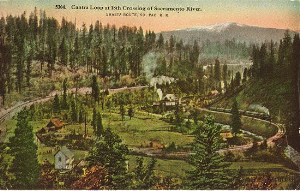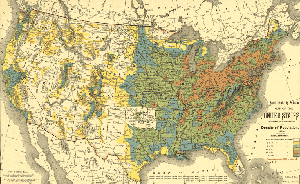Results of railroad history
European railroads were built to connect existing settlements, at the ends of the route and along the way. They had customers from day one. When railroads were built in the West of the USA, there were no settlements along the way. The railroads had to bring the settlers.
Economic result was a delay in payback on investment, that was difficult to survive. Track layout had to adapt to this situation: "Build fast and cheap, improve later!" In difficult terrain, one consequence was a very small curve radius.

For climbing out of the Sacramento River Canyon, Southern Pacific has chosen a curve radius of 410 feet.
"Cantara Loop" still exists, owned by Union Pacific today.
A very small curve radius is normally avoided by railroads. It's not just bad for speed, but also adds
resistance, wear, and maintenance costs. For tight curves, the curve resistance of a train needs to be calculated. Most
railroad cars have an axle between the wheels, there is no differential, so the difference in distance results in creeping
motion of the wheels, adding resistance. As a rule of thumb, calculating curve resistance gets necessary at a radius below
800 feet. If the curves get tighter, below 600 feet of radius, the wheel flange might constantly rub the rail. And finally,
the wheel will run on the curved transition towards the flange, lifting the carriage a tiny distance.
The numbers are just rules of thumb, there is a lot of variation, that depends on flange form, railhead form, the allowed
amount of play, and more factors. A major factor is the track gauge: Narrow-gauge railroads have far less problems.
While European narrow-gauge lines were built with very tight curves as well, The tightest curves of the trunk route network are about 590 feet in radius, and this is an exception, found only on mountain routes like the Semmering in Austria. As a result, most of the European mainline passenger trains are built for a minimum curve radius of 492 feet.

In 1890, population density was still very low in major parts of the West. This hasn't changed fundamentally until
today.
In the USA, the first part of "build fast and cheap, improve later!" happened, but the "improve later" has had a problem: While the former "Wild West" was no longer wild, and was reached by a lot of settlers, this settlement did not result in a population density, that could have made major investments an easy task. While lots of cutoffs and improvements were built, major parts of the network show the cost cuts of the 19th century until today.
A radius of 574 feet is quite common in the USA, 410 feet radius is nothing unusual, and the tightest curves in the network have a radius of 288 feet. Most of the European mainline passenger trains are not able to negotiate such curvature without modifications.
An additional problem is a common fix for a standard problem of tilting trains: Station approaches with several crossovers in rapid succession cause excessive sway. Most of the European tilting trains "fix" this problem by cutting out the tilting system at 43.5 mph. Operation in the USA might need a more sophisticated approach, since the extremely tight curves might result in lower curve speeds en route, even for tilting trains.